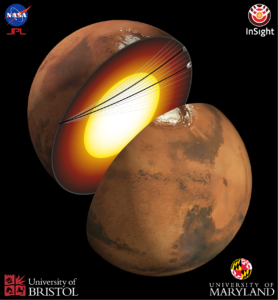Mars has a liquid iron alloy core at its center. Using seismic data gathered by the InSight mission, we have made the first observations of seismic waves traveling through Mars’ core. We use the travel times of core-transiting seismic waves, relative to ones which remain in the mantle, to constrain properties of the core and construct the first models of the elastic properties of the entire planet. Our results are consistent with a core rich in sulfur, with smaller fractions of oxygen, carbon and hydrogen.
 This is the first-ever detection of waves that travel through the Martian core. In 2021, based on data recorded by the InSight VBB seismometer, we were able to detect waves reflecting off the core (analogous to sound echoes one can hear reflecting from a wall). These waves were produced by marsquakes that were relatively close to the InSight lander. However, during the extended mission (i.e. second martian year of the lander operating on the surface of Mars), we were able to detect seismic events much further from the lander. One of these, called S0976a, was a marsquake on the other side of Mars, located close to Valles Marineris (the largest canyon in the solar system). The other, S100a, was a large impact. Waves from these waves traveled through the martian mantle and then entered the core. By looking at the relative travel times of waves that stayed in the mantle, we were able to use these waves to determine the speed at which elastic waves travel through the martian core, which provides constraints on not just the size of the core — which we could independently estimate from the timing of the echoes I mention earlier — but also on the properties of the liquid iron alloy that makes up the core. These properties suggest that the martian core contains a large amount (about 1/5th of the core by mass) of “light elements”, including sulfur, oxygen, carbon and a dash of hydrogen. This is the first direct constraint on the properties of the materials constituting the martian core and provides important clues about how Mars formed and what the conditions in its interior are at present.
This is the first-ever detection of waves that travel through the Martian core. In 2021, based on data recorded by the InSight VBB seismometer, we were able to detect waves reflecting off the core (analogous to sound echoes one can hear reflecting from a wall). These waves were produced by marsquakes that were relatively close to the InSight lander. However, during the extended mission (i.e. second martian year of the lander operating on the surface of Mars), we were able to detect seismic events much further from the lander. One of these, called S0976a, was a marsquake on the other side of Mars, located close to Valles Marineris (the largest canyon in the solar system). The other, S100a, was a large impact. Waves from these waves traveled through the martian mantle and then entered the core. By looking at the relative travel times of waves that stayed in the mantle, we were able to use these waves to determine the speed at which elastic waves travel through the martian core, which provides constraints on not just the size of the core — which we could independently estimate from the timing of the echoes I mention earlier — but also on the properties of the liquid iron alloy that makes up the core. These properties suggest that the martian core contains a large amount (about 1/5th of the core by mass) of “light elements”, including sulfur, oxygen, carbon and a dash of hydrogen. This is the first direct constraint on the properties of the materials constituting the martian core and provides important clues about how Mars formed and what the conditions in its interior are at present.
